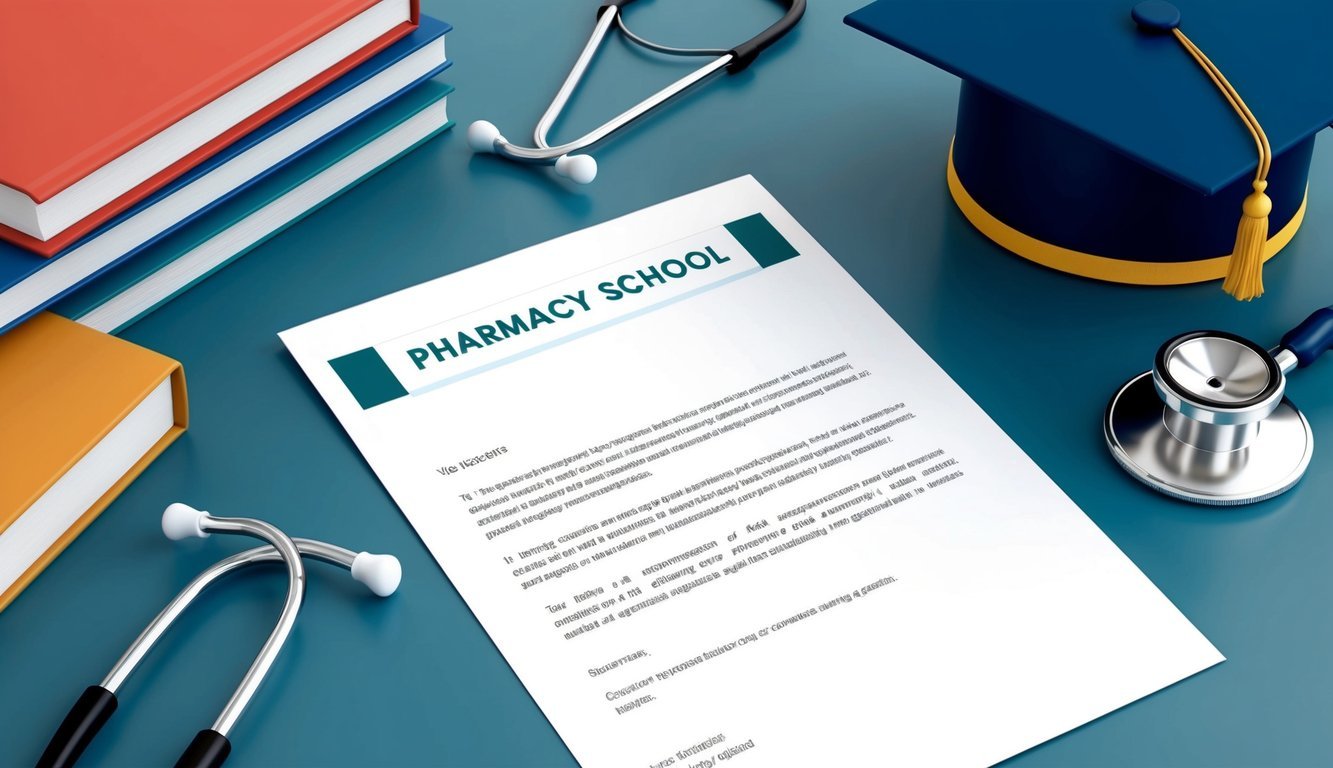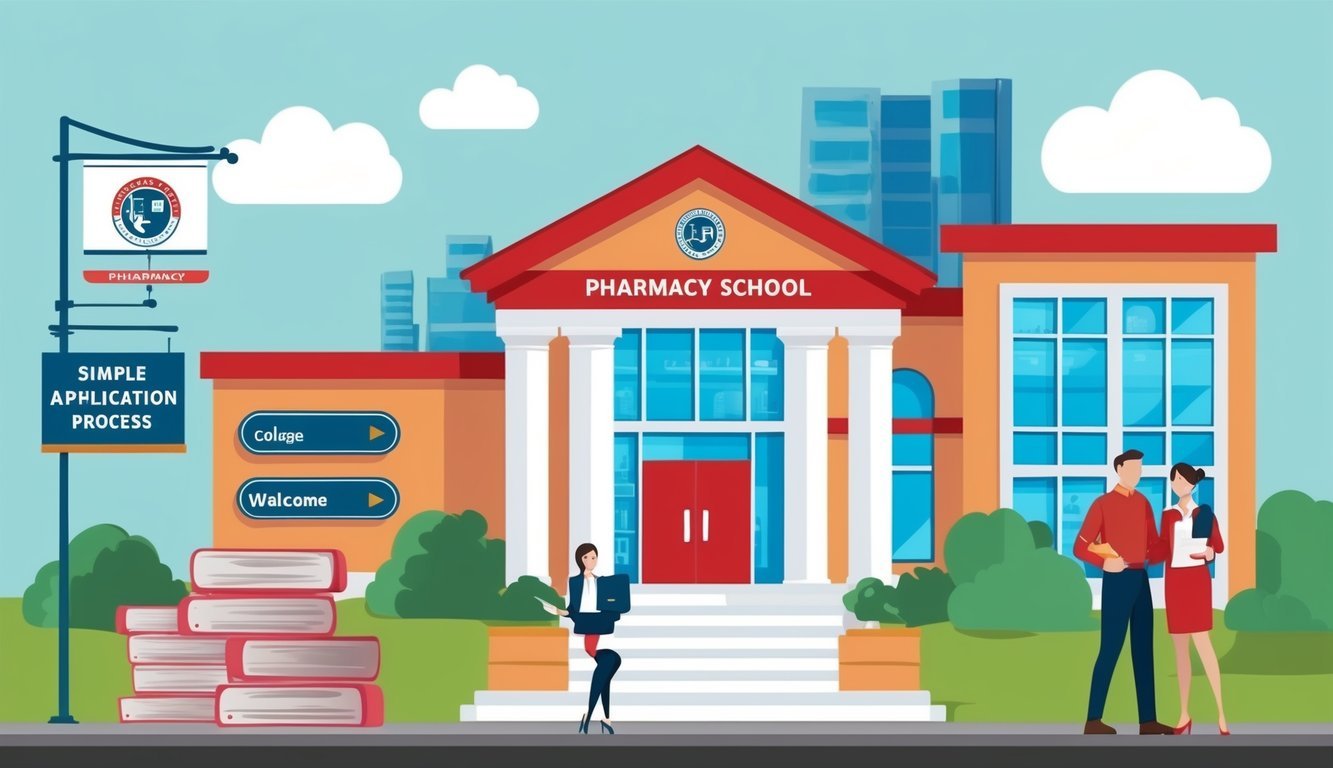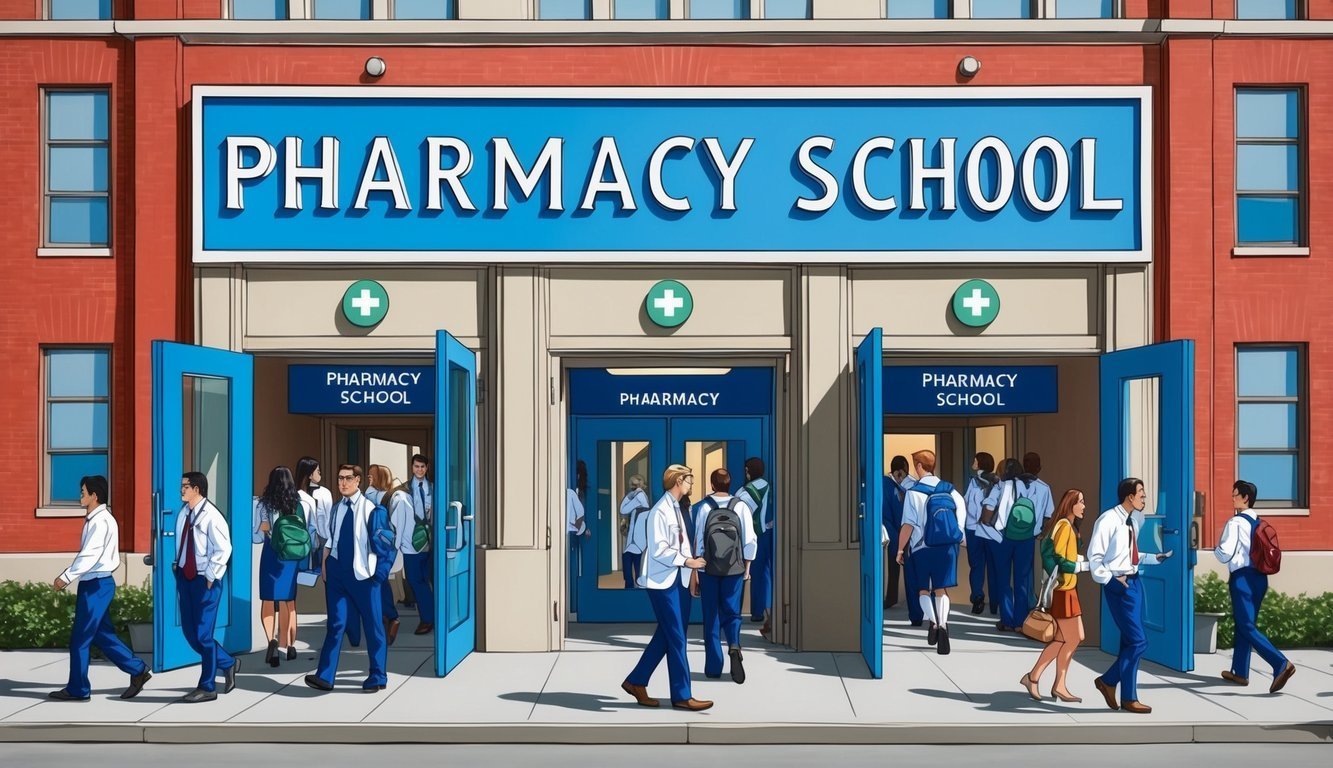Deciding to pursue a career in pharmacy is an exciting step.
If you’ve been searching for the easiest pharmacy schools to get into, you’re not alone. The University of Kansas School of Pharmacy is recognized as the easiest school to gain admission, boasting an acceptance rate of 74% with a minimum GPA requirement of 2.50. Knowing where to apply can make your journey to becoming a pharmacist much smoother.
This article will guide you through various pharmacy schools that have higher acceptance rates and offer valuable insights into their admission requirements.
You’ll learn about the factors to consider when choosing a school, including financial aspects and the potential for postgraduate success.
Navigating the admissions process can be daunting, but arming yourself with the right information is key to achieving your goals.
With the right preparation and understanding of what these schools offer, you can increase your chances of acceptance and launch a fulfilling career in pharmacy.
Key Takeaways
- Some pharmacy schools have notably high acceptance rates, helping you find the best fit.
- Financial considerations are important when choosing a pharmacy school.
- Understanding the curriculum can impact your success after graduation.
Understanding Pharmacy School Admissions
Pharmacy school admissions involve several key components you should know.
Each pharmacy school has its own specific requirements, but knowing the general expectations can help you prepare effectively.
Admission Requirements
Each pharmacy school sets its own admission requirements, so it’s crucial to research the schools you’re interested in.
Generally, you will need to provide an application that includes your academic transcripts, letters of recommendation, and a personal statement.
Most schools require you to have completed specific prerequisite courses that focus on science and mathematics.
Schools may also require completion of the Pharmacy College Admission Test (PCAT), which assesses your readiness for pharmacy school.
Here are common components needed:
- Transcripts: From all colleges you’ve attended.
- Letters of Recommendation: Usually from professors or professionals in the field.
- Personal Statement: Explaining your motivation for entering the PharmD program.
Pharmacy College Admission Test (PCAT)
The PCAT is a standardized test specifically designed for prospective pharmacy students.
It is often a requirement for admission to pharmacy schools.
The test evaluates your knowledge in areas such as:
- Biology
- Chemistry
- Mathematics
- Reading Comprehension
- Verbal Ability
Preparing for the PCAT is essential, as your scores can significantly influence your application.
Many resources are available online to help you study, including practice tests and tips for improvement.
Minimum GPA and Prerequisite Courses
Most pharmacy schools have a minimum GPA requirement, typically around 2.5 to 3.0 on a 4.0 scale.
This ensures that you have a solid academic background necessary for the rigorous PharmD program.
Additionally, prerequisite courses are critical.
Common courses include:
- Biology with lab
- General and organic chemistry with lab
- Calculus
- Microbiology
Meeting these requirements demonstrates your preparedness for the challenges of pharmacy school.
Make sure to check each school’s specific requirements to ensure you’re on the right track.
Interview and Personal Statement
The interview is an important step in the admissions process.
It allows schools to assess your suitability for the profession and your commitment to a career in pharmacy.
During the interview, you may be asked about your understanding of the pharmacy field and your motivations.
Prepare to discuss your experiences, your personal statement, and any relevant projects or work.
Your personal statement is another crucial factor.
This document should reflect your passion for pharmacy and your future goals.
It’s your opportunity to stand out from other applicants, so make it personal and genuine.
Evaluating Pharmacy School Acceptance Rates
Understanding acceptance rates is essential when choosing a pharmacy school.
These rates reflect how many applicants are admitted and can help you assess your chances of getting into specific programs.
Analyzing Acceptance Rates
Acceptance rates vary widely among pharmacy schools.
For example, the University of Kansas School of Pharmacy has a high acceptance rate of 74%, making it one of the easier options for applicants.
In contrast, some schools may have acceptance rates below 50%.
| School Name | Acceptance Rate | Minimum GPA |
|---|---|---|
| University of Kansas School of Pharmacy | 74% | 2.50 |
| Albany College of Pharmacy and Health Sciences | 75.2% | 3.0 |
These rates are crucial as they indicate how competitive a program is.
If you want a better chance of acceptance, it’s wise to target schools with higher rates.
Factors Affecting Acceptance Rates
Several factors influence pharmacy school acceptance rates.
First, the minimum GPA requirements can change based on the school’s standards.
Many schools expect a GPA of at least 3.0.
Admissions criteria, such as recommendation letters and interview performance, also play significant roles.
Strong letters can help offset a lower GPA.
Additionally, some programs may have less stringent requirements for certain groups, which can affect overall acceptance rates.
Schools like Virginia Commonwealth University are known for unique admissions criteria that make them more accessible to applicants.
Targeting the Easiest Schools for Admission
Choosing the right pharmacy school can significantly impact your journey toward becoming a pharmacist.
Identifying schools with higher acceptance rates and more flexible entry requirements is essential.
Here are the key criteria for selecting the easiest schools, followed by some notable options.
Criteria for ‘Easiest’ Schools
When evaluating pharmacy schools, focus on acceptance rates, GPA requirements, and the total number of applicants.
Key criteria include:
- Acceptance Rate: Higher rates suggest easier admission. For example, the University of Kansas has an acceptance rate of 74%.
- GPA Requirements: Look for schools with lower GPA thresholds. Schools like the University of Kentucky often require a minimum GPA of around 2.50.
- Program Duration and Costs: Consider the length and total costs of the program. Some schools may offer affordable tuition alongside shorter programs.
Evaluate schools based on these factors to find the ones that align with your qualifications and goals.
Notable Easy-to-Enter Pharmacy Schools
Several pharmacy schools stand out for their accessibility.
Consider these options:
| School Name | Acceptance Rate | Minimum GPA Requirement |
|---|---|---|
| University of Kansas | 74% | 2.50 |
| University of Kentucky | Varies | 2.50 |
| University of the Incarnate Word | Moderate | 2.75 |
| Southwestern Oklahoma State University | Moderate | 2.75 |
| South College School of Pharmacy | Varies | 2.50 |
| University of Montana | Moderate | 2.50 |
These schools provide various pathways to a pharmacy degree.
Each has specific admission criteria.
Research each school thoroughly and choose the one that fits your academic profile and professional aspirations.
You can find more on the easiest pharmacy schools to get into.
Financial Considerations of Pharmacy Schools

When considering pharmacy schools, you should pay close attention to tuition fees and the financial aid available.
Understanding the cost differences between in-state and out-of-state tuition can significantly impact your budget and choices.
Tuition Fees and Financial Aid
Tuition fees for pharmacy programs vary widely.
On average, public universities charge over $23,000 per year for in-state students, while out-of-state students might pay more than $38,000 annually.
Private universities generally have higher tuition, often exceeding $40,000 per year.
It’s essential to research the specific schools you’re interested in, as some may offer lower tuition rates or better financial aid packages.
Many schools have scholarships, grants, and loans available specifically for pharmacy students.
You can explore options through organizations like the American Association of Colleges of Pharmacy, which provide information on scholarships and financial aid tailored for pharmacy education.
In-state vs. Out-of-state Tuition
In-state tuition rates are typically lower than out-of-state rates at public colleges.
If you live in the state where the university is located, you may qualify for considerable savings.
For example, the University of Kansas School of Pharmacy offers competitive in-state tuition, which can be a significant advantage.
On the other hand, out-of-state students may face a much higher financial burden.
While considering where to apply, evaluate both the costs and the potential financial aid.
Some schools may provide better opportunities or incentives for out-of-state students, so it’s worth researching various programs to find the best fit for your financial situation.
Curriculum and Postgraduate Success

The curriculum of pharmacy schools is designed to equip you with the necessary knowledge and skills for a successful career in the healthcare field.
This section discusses key components of pharmacy education, including the core curriculum, clinical experiences, and your journey to becoming a licensed pharmacist.
Pharmacy Curriculum Overview
In a typical PharmD program, you will cover essential topics in pharmaceutical sciences and pharmacy practice.
Courses often include:
- Pharmacology: Study how drugs affect the body.
- Pharmacy Law and Ethics: Understand the regulations guiding pharmacy practice.
- Clinical Pharmacy: Focus on patient care and medication management.
Most programs combine lectures with laboratory work to reinforce learning.
Additionally, courses on public health prepare you for broader community health roles.
Clinical Rotations and Patient Care
Clinical rotations are a vital part of your pharmacy education.
During these rotations, you will gain hands-on experience in various settings, including hospitals, clinics, and community pharmacies.
Typical components include:
- Direct Patient Care: Engaging with patients to manage medications.
- Interdisciplinary Teams: Collaborating with healthcare professionals to provide optimal care.
- Real-World Challenges: Addressing actual clinical situations prepares you for future roles.
These experiences are crucial for developing your critical thinking and communication skills.
They also help foster a deeper understanding of how to improve patient health outcomes.
Licensure and Career Prospects
After completing your education, you will need to pass the North American Pharmacist Licensure Examination (NAPLEX) to become a licensed pharmacist.
Ensure you are well-prepared, as this is a critical step in your career.
Once licensed, career prospects are varied.
You can work in areas such as:
- Community Pharmacy: Dispensing medications and providing consultations.
- Hospital Pharmacy: Working in a clinical environment.
- Public Health: Promoting health strategies within communities.
Pharmacists are essential in the healthcare field, with increasing demand for their expertise in managing patient care and public health initiatives.
Frequently Asked Questions

This section addresses common inquiries about pharmacy schools with easier admission processes.
You will find information regarding acceptance rates, GPA thresholds, and how international students can navigate the application process.
What are the acceptance rates for pharmacy schools known for easier admission?
Acceptance rates can vary widely among pharmacy schools.
Schools like the University of Kansas have a higher acceptance rate compared to more competitive programs.
Generally, the easiest pharmacy schools to get into might have acceptance rates ranging from 50% to 70%.
How does an international student’s application differ when applying to pharmacy schools with higher acceptance rates?
International students may face additional requirements when applying to pharmacy schools.
This can include submitting TOEFL or IELTS scores to demonstrate English proficiency.
Some schools might also require evaluations of foreign transcripts to ensure they meet U.S. standards.
What GPA thresholds are typically considered by pharmacy schools with less stringent entry requirements?
Pharmacy schools with easier admissions usually have lower GPA thresholds.
Many will accept students with a minimum GPA of 2.5.
However, some schools may consider lower GPAs if the applicant shows strong potential through other aspects of their application.
Which pharmacy schools have historically had the lowest entry requirements?
Some pharmacy schools are known for having lower entry requirements.
For example, South College School of Pharmacy and Texas Southern University are often highlighted for their more relaxed standards.
They tend to focus on a holistic review process rather than just GPA.
How do pharmacy school requirements vary by state for schools with higher acceptance rates?
Requirements can differ by state.
For example, some states may have specific prerequisites or additional tests.
You should check each school’s requirements in the state you are interested in to understand what is needed for admission.
Are there any recent changes in admission trends for pharmacy schools that are traditionally easier to get into?
Recently, some pharmacy schools have started adjusting their admission processes.
Changes may include a shift toward more holistic reviews of applications.
This trend allows schools to consider attributes beyond GPA, such as community service and pharmacy experience, making it easier for diverse applicants to gain entry.

